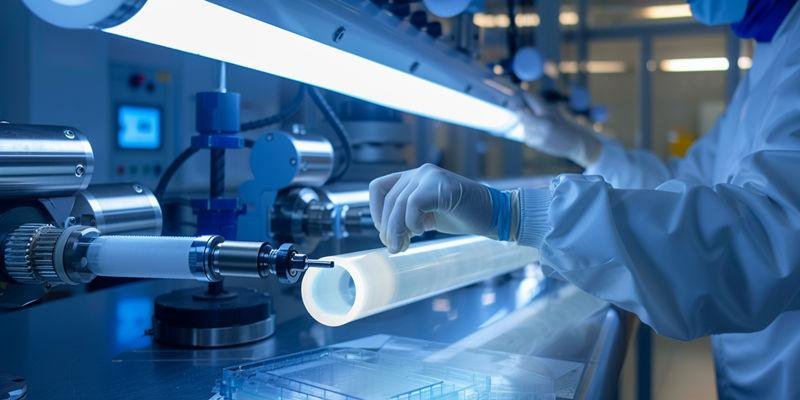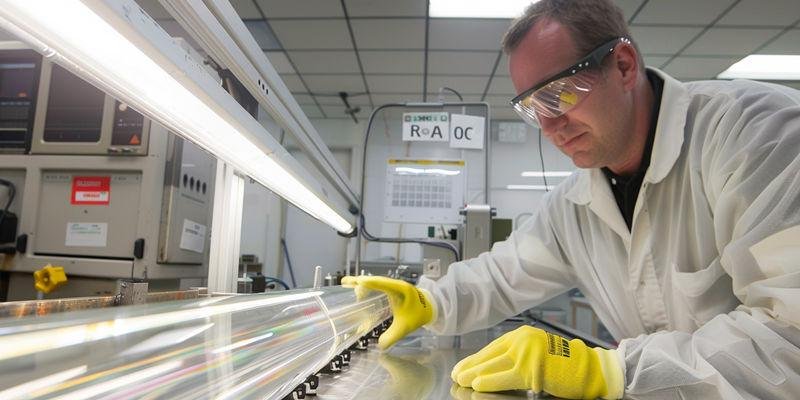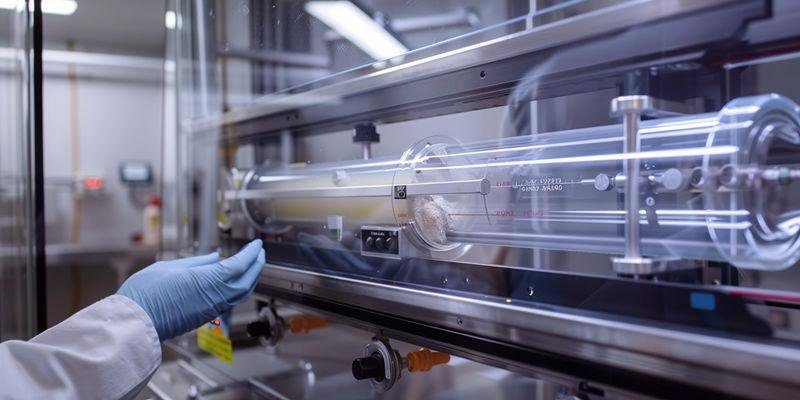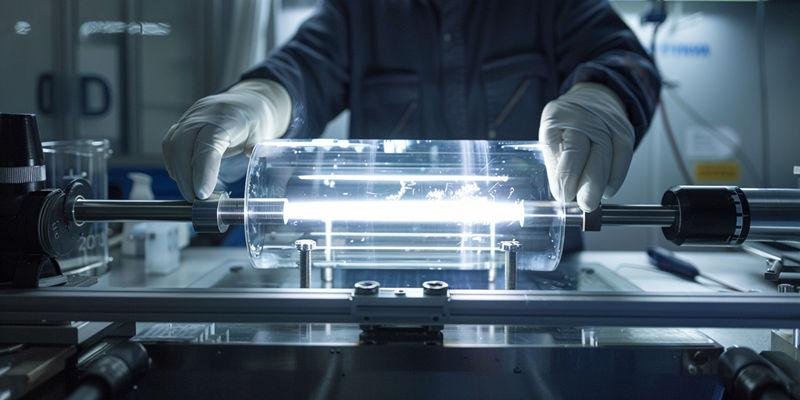올바른 석영 유리 제조 공정을 선택하는 것은 고성능 소재를 필요로 하는 산업에서 중요한 엔지니어링 과제입니다.
석영 유리 제조에는 2000°C 이상의 온도에서 고순도 실리카를 녹이고, 연속 또는 불연속적인 방법을 통해 원하는 모양으로 재료를 성형하고, 내부 응력을 완화하기 위해 어닐링하는 세 가지 주요 공정이 포함됩니다. 화염 용융, 전기 용융 또는 솔젤 공정 중 어떤 공정을 선택할지는 필요한 순도 수준과 최종 적용 분야에 따라 달라집니다.

제조 공정을 이해하는 것은 자재 선택, 성능 및 공급업체 평가에 대한 정보에 입각한 결정을 내리는 데 필수적입니다. 다음 섹션에서는 프로세스 기본 사항부터 실질적인 조달 전략까지 각 측면을 자세히 살펴봅니다.
석영 유리는 어떻게 생산되나요?
산업계는 까다로운 환경에 맞는 자료를 소싱할 때 복잡한 요구 사항에 직면합니다.
석영 유리 제조는 고순도 석영 유리의 제어된 변형을 의미합니다. 이산화 규소 를 고온 공정을 통해 비정질 유리로 변환합니다. 이 공정은 소재의 순도, 광학적 선명도, 열충격에 대한 저항성을 결정하기 때문에 매우 중요합니다.

석영 유리는 뛰어난 열 안정성, 내화학성, 광학 특성으로 높은 평가를 받고 있습니다. 이러한 특성은 제조 공정에 직접적인 영향을 받기 때문에 반도체, 광학 및 실험실 장비의 응용 분야에 필수적입니다.
석영 유리 제조의 주요 측면
| 측면 | 설명 |
|---|---|
| 원재료 | 고순도 실리카(SiO₂) |
| 녹는 온도 | >2000°C |
| 형성 방법 | 연속형, 불연속형 또는 솔겔형 |
| 순도 관리 | 금속 및 기체 불순물 제거 |
| 애플리케이션 | 반도체, UV 광학, 실험실 용품, 고온 부품 |
석영 유리 품질에 제조 공정이 중요한 이유는 무엇인가요?
까다로운 애플리케이션에서 일관된 성능을 달성하려면 정밀한 프로세스 제어가 필요합니다.
제조 공정은 다음 사항에 직접적인 영향을 미칩니다. 석영 유리 불순물 수준, 미세 구조 및 기계적 특성에 영향을 미쳐 품질에 영향을 미칩니다. 예를 들어 화염 용융은 금속 불순물이 유입될 수 있고, 전기 용융은 순도가 높지만 비용이 증가합니다.
공정 선택은 광 투과, 열팽창, 탈석화 저항에 영향을 미칩니다. 제조업체는 애플리케이션별 요구 사항을 충족하기 위해 비용, 처리량, 품질 간의 균형을 맞춰야 합니다.
주요 속성에 대한 제조 공정의 영향
| 속성 | 불꽃 융합 | 전기 용융 | 솔-젤 |
|---|---|---|---|
| 순도(SiO₂, %) | 99.95-99.98 | 99.99-99.999 | 99.99+ |
| 광 전송(%) | 85-90(UV) | 90-95(자외선) | 92-96(UV) |
| 버블 함량(개/cm³) | 10-20 | 1-5 | <1 |
| 비용 지수 | 낮음 | 중간-높음 | 높음 |
석영 유리의 주요 제조 방법은 무엇인가요?
최적의 제조 방법을 선택하는 것은 재료 특성을 최종 사용 요구 사항에 맞추는 데 있어 중요한 단계입니다.
석영 유리는 여러 가지 방법으로 생산할 수 있으며, 각 방법마다 고유한 장점과 한계가 있습니다. 세 가지 주요 기술은 화염 융합, 전기 용융, 솔젤 가공입니다.

각 방법마다 순도 수준, 구조적 특성, 비용 프로필이 다르기 때문에 엔지니어와 조달 전문가에게 공정 선택은 매우 중요한 결정입니다.
석영 유리 제조 방법 개요
| 방법 | 최대 온도(°C) | 일반 순도(%) | 주요 애플리케이션 | 비용 수준 |
|---|---|---|---|---|
| 불꽃 융합 | 2000-2200 | 99.95-99.98 | 조명, 일반 실험실용품 | 낮음 |
| 전기 용융 | 2000-2300 | 99.99-99.999 | 반도체, 광학 | 중간-높음 |
| 솔-젤 | <1500 | 99.99+ | 특수 광학, 코팅 | 높음 |
화염 융합 프로세스
플레임 퓨전은 비용 효율성과 확장성 때문에 종종 선택됩니다.
화염 융합은 가스-산소 불꽃을 사용하여 고순도 실리카 모래를 녹인 다음 용융 된 물질을 다음과 같이 성형하는 것입니다. 쿼츠 튜브막대 또는 판을 사용합니다. 이 방법은 초고순도가 중요하지 않은 표준 석영 유리 제품을 생산하는 데 널리 사용됩니다.
화염 용융은 UV 램프, 일반 실험실 유리 제품 및 일부 산업용 부품과 같은 애플리케이션에 적합합니다. 그러나 미량의 금속 불순물과 기포가 발생하여 광학 및 기계적 성능에 영향을 미칠 수 있습니다.
전기 용융 공정
고순도와 우수한 광학적 특성이 필요한 경우 전기 용융이 선호됩니다.
전기 용융에서는 백금 또는 세라믹 도가니에서 전기 저항 또는 유도 가열을 사용하여 실리카를 녹입니다. 이 공정은 오염을 최소화하여 순도가 높고 내포물이 적은 석영 유리를 만듭니다.
전기 용융은 일반적으로 반도체 기판, 고정밀 광학 부품 및 엄격한 품질 표준이 요구되는 애플리케이션에 사용됩니다. 이 공정은 장비와 에너지 비용으로 인해 더 비싸지만 우수한 재료 성능을 제공합니다.
솔-젤 프로세스
솔-젤 공정은 맞춤형 미세 구조가 필요한 특수 애플리케이션을 위해 선택됩니다.
솔-젤 제조에는 실리콘 알콕사이드를 가수분해하여 콜로이드 현탁액(솔)을 형성한 다음 겔화하여 저온에서 건조 및 소결하는 과정이 포함됩니다. 이 방법을 사용하면 구성과 다공성을 정밀하게 제어할 수 있습니다.
솔겔 석영 유리는 고유한 특성이 필요한 고급 광학, 코팅 및 연구 분야에 사용됩니다. 공정이 복잡하고 비용이 많이 들기 때문에 틈새 시장으로 사용이 제한됩니다.
다양한 원자재가 제조 결과에 어떤 영향을 미칠까요?
재료 선택은 전체 제조 공정을 형성하는 기초적인 결정입니다.
천연 석영, 합성 실리카, 고순도 모래 등 원료의 선택은 최종 제품의 달성 가능한 순도, 광학적 선명도, 기계적 강도에 영향을 미칩니다. 출발 물질의 불순물은 색 중심, 자외선 투과율 감소, 열 안정성 저하로 이어질 수 있습니다.
제조업체는 고급 애플리케이션에 합성 실리카를 사용하는 경우가 많으며, 천연 석영은 덜 까다로운 용도에 적합합니다. 선택 과정에서는 비용과 성능 요구 사항을 모두 고려해야 합니다.
석영 유리 특성에 대한 원자재 영향
| 원재료 | 일반 순도(%) | 자외선 투과(%) | 열 안정성(°C) | 주요 사용 사례 |
|---|---|---|---|---|
| 천연 석영 | 99.5-99.8 | 80-85 | 1100-1200 | 일반 산업, 조명 |
| 고순도 모래 | 99.8-99.99 | 85-90 | 1200-1300 | 실험실, 표준 광학 |
| 합성 실리카 | 99.99-99.999 | 90-95 | 1300-1500 | 반도체, 하이엔드 광학 |
특정 제조 방식이 필요한 애플리케이션에는 어떤 것이 있을까요?
최적의 성능을 위해서는 애플리케이션 요구 사항에 맞는 제조 방법을 선택하는 것이 필수적입니다.
반도체 및 자외선 광학 등 특정 산업에서는 순도가 매우 높고 결함이 최소화된 석영 유리를 필요로 합니다. 이러한 경우 전기 용융 또는 솔-젤 공정이 선호됩니다. 일반 실험실 또는 산업용의 경우 화염 용융으로 충분할 수 있습니다.
올바른 공정을 선택하면 재료가 용도에 맞는 성능, 내구성 및 규제 표준을 충족할 수 있습니다.
애플리케이션별 제조 방법 선택
| 적용 분야 | 필수 순도(%) | 선호하는 방법 | 주요 성과 기준 |
|---|---|---|---|
| 반도체 웨이퍼 | 99.999 | 전기 용융 | 낮은 불순물, 높은 균질성 |
| UV 광학 | 99.99+ | 전기 용융/솔-젤 | 높은 자외선 투과율 |
| 실험실 장비 | 99.95-99.99 | 불꽃 융합 | 내화학성, 비용 |
| 고온 도가니 | 99.98-99.99 | 화염 융합/전기 용융 | 열 충격 저항 |
연속 제조와 비연속 제조: 어떤 프로세스가 더 나은 결과를 제공할까요?
연속 프로세스와 불연속 프로세스 중 하나를 선택하는 것은 엔지니어링적으로 중요한 과제입니다.
연속 제조는 높은 처리량과 일관된 품질을 제공하는 반면, 불연속(배치) 프로세스는 소규모 생산 및 특수 제품에 대한 제어를 강화할 수 있습니다. 이러한 선택은 비용, 확장성 및 제품 균일성에 영향을 미칩니다.
이러한 접근 방식 간의 장단점을 이해하는 것은 프로덕션 기능을 애플리케이션 요구 사항에 맞추는 데 필수적입니다.
프로세스 비교: 연속형과 불연속형
| 매개변수 | 연속 프로세스 | 불연속 프로세스 |
|---|---|---|
| 처리량(kg/h) | 100-500 | 10-100 |
| 순도 관리 | 보통 | 높음 |
| 비용 효율성 | 높음 | 중간-낮음 |
| 사용자 지정 | 제한적 | 높음 |
| 일반적인 애플리케이션 | 표준 튜브, 로드 | 특수 광학, 맞춤형 부품 |
연속 프로세스의 장점은?
연속 프로세스는 대규모의 표준화된 생산에 이상적입니다.
일관된 치수와 특성으로 대량 출력이 가능하므로 석영 튜브와 같은 제품에 적합합니다. 용융 실리카 로드 조명 및 산업용 난방에 사용됩니다. 자동화를 통해 인건비를 절감하고 반복성을 개선할 수 있습니다.
불연속 프로세스 혜택?
불연속 프로세스는 유연성과 품질 관리 측면에서 탁월합니다.
배치 생산은 공정 파라미터를 정밀하게 조정할 수 있어 순도를 높이고 미세 구조를 더 잘 제어할 수 있습니다. 이 접근 방식은 맞춤형 구성 요소, 특수 광학 및 소량과 엄격한 사양이 필요한 애플리케이션에 선호됩니다.
제조 방식은 품질과 비용 측면에서 어떻게 비교되나요?
충돌하는 데이터를 탐색하려면 기본 원칙을 명확하게 이해해야 합니다.
제조 방법은 품질과 비용 면에서 큰 차이가 있습니다. 화염 용융은 비용 효율적이지만 순도가 떨어질 수 있는 반면, 전기 용융과 솔젤은 더 높은 가격에 우수한 특성을 제공합니다. 최적의 선택은 성능 요구 사항과 예산 제약의 균형을 맞추는 데 달려 있습니다.

엔지니어와 조달 팀은 결함이나 최적의 재료 성능 미달로 인한 잠재적 수율 손실을 포함하여 직접 및 간접 비용을 모두 평가해야 합니다.
제조 방법의 품질 및 비용 비교
| 방법 | 순도(SiO₂, %) | 광 전송(%) | kg당 비용(USD) | 일반적인 결함률(%) |
|---|---|---|---|---|
| 불꽃 융합 | 99.95-99.98 | 85-90 | 10-20 | 2-5 |
| 전기 용융 | 99.99-99.999 | 90-95 | 25-50 | <1 |
| 솔-젤 | 99.99+ | 92-96 | 50-100 | <0.5 |
석영 유리 제조에서 중요한 비용 요소는 무엇인가요?
비용 분석은 조달 및 프로젝트 계획에서 중요한 단계입니다.
주요 원가 요인으로는 원재료 순도, 에너지 소비, 장비 감가상각, 인건비, 수율 등이 있습니다. 고순도 재료와 첨단 용융 기술은 비용을 증가시키지만 성능 향상과 불량률 감소로 이를 정당화할 수 있습니다.

이러한 요소를 이해하면 보다 정확한 예산 책정과 공급업체 협상이 가능합니다.
석영 유리 제조 비용 분석
| 비용 구성 요소 | 일반 공유(%) | 참고 |
|---|---|---|
| 원재료 | 30-50 | 초순수 등급의 경우 더 높음 |
| 에너지 | 20-30 | 2000°C 이상에서 녹는 것은 에너지 집약적입니다. |
| 장비 감가상각 | 10-20 | 플래티넘 도가니는 비용을 증가시킵니다. |
| 노동 | 10-15 | 자동화를 통해 이 점유율 감소 |
| 수익률 손실 | 5-10 | 처리 중 결함 및 파손 |
공급업체를 선정할 때 제조 역량을 평가하는 방법은 무엇인가요?
공급업체 평가는 위험 관리 및 품질 보증의 중요한 구성 요소입니다.
공급업체의 제조 역량을 평가하려면 공정 기술, 품질 인증, 생산 능력, 유사 애플리케이션에 대한 실적 등을 검토해야 합니다. 중요도가 높은 프로젝트의 경우 현장 감사와 샘플 테스트를 권장합니다.
자세한 프로세스 문서와 테스트 보고서를 요청하면 공급업체가 기술 및 배송 요구 사항을 충족할 수 있습니다.
공급업체 역량 평가 기준
| 평가 측면 | 주요 질문 | 요청할 증거 자료 |
|---|---|---|
| 프로세스 기술 | 어떤 용융/성형 방법을 사용하나요? | 프로세스 순서도, 장비 목록 |
| 순도 관리 | 불순물 제거는 어떻게 확인되나요? | 테스트 보고서, 인증서 |
| 생산 능력 | 최대 배치/연속 출력량은 얼마인가요? | 생산 기록 |
| 품질 인증 | ISO 또는 업계 표준을 충족하나요? | ISO 9001, 관련 인증서 |
| 애플리케이션 경험 | 공급업체가 유사한 산업에 서비스를 제공한 적이 있나요? | 참조 프로젝트, 고객 목록 |
제조업체에 어떤 품질 관리 기준을 기대해야 하나요?
품질 관리 표준은 제품의 일관성과 신뢰성을 보장하는 데 필수적입니다.
제조업체는 원자재 분석, 공정 중 모니터링, 최종 제품 테스트를 포함한 엄격한 검사 프로토콜을 구현해야 합니다. ISO 9001 및 ASTM 사양과 같은 국제 표준을 준수하는 것은 품질에 대한 노력을 나타내는 강력한 지표입니다.
구매자는 각 배송에 대한 완전한 추적성, 배치 문서화 및 테스트 데이터에 대한 액세스를 기대해야 합니다.
석영 유리 제조의 일반적인 품질 관리 조치
| QC 단계 | 테스트/검사 수행 | 표준/방법 | 빈도 |
|---|---|---|---|
| 원재료 | 화학적 순도 분석 | ICP-OES, XRF | 각 배치 |
| 용융/성형 | 온도 및 대기 제어 | 프로세스 로그 | 연속 |
| 최종 제품 | 광학 전송, 버블 수 | UV-Vis, 현미경 | 각 로트 |
| 문서 | 배치 추적성 | ISO 9001, 내부 SOP | 모든 발송물 |
석영 유리 제조 방법 선택을 위한 의사 결정 프레임워크
정보에 입각한 선택을 하려면 프로세스, 애플리케이션, 공급업체 요인에 대한 체계적인 평가가 필요합니다.
이 의사 결정 프레임워크는 최적의 제조 방법과 공급업체를 선택하기 위한 주요 질문과 기준을 통해 엔지니어와 조달 팀을 안내합니다.
석영 유리 제조 결정 체크리스트
| 단계 | 핵심 질문 | 권장 조치 |
|---|---|---|
| 1 | 필요한 순도와 성능은 무엇인가요? | 애플리케이션별 기준 정의 |
| 2 | 이러한 요구 사항을 충족하는 제조 방법은 무엇일까요? | 화염 융합, 전기 용융, 솔-젤 비교 |
| 3 | 허용되는 비용 범위는 어떻게 되나요? | 품질과 예산 제약의 균형 맞추기 |
| 4 | 어떤 공급업체가 검증된 기능을 제공하나요? | 인증, 프로세스 문서 검토 |
| 5 | 품질 관리 표준이 문서화되어 있나요? | 테스트 보고서 및 추적 정보 요청 |
| 6 | 사용자 지정 또는 소량 배치가 필요하신가요? | 불연속/배치 프로세스 고려하기 |
| 7 | 공급업체가 기술 지원을 제공할 수 있나요? | 엔지니어링 및 애프터서비스 평가 |
결론
최적의 결과를 얻으려면 석영 유리 제조 방법을 애플리케이션 요구 사항에 맞춰야 합니다.
석영 유리 제조의 복잡성을 헤쳐 나가려면 기술적 통찰력과 신뢰할 수 있는 파트너가 모두 필요합니다. 고순도 소재와 전문가의 안내를 통해 프로젝트에 필요한 석영 유리 요구 사항에 대한 맞춤형 상담을 받으려면 TOQUARTZ의 공장 직접 공급, 엔지니어링 지원 및 신속한 배송을 활용하세요.
자주 묻는 질문(FAQ)
용융 석영과 용융 실리카의 차이점은 무엇인가요?
퓨즈드 쿼츠는 천연 석영으로 만들어지는 반면 퓨즈드 실리카는 합성 전구체로 생산됩니다. 용융 실리카는 일반적으로 순도가 높고 자외선 투과율이 더 우수합니다.
공급업체로부터 석영 유리의 순도를 확인하려면 어떻게 해야 하나요?
ICP-OES 또는 XRF 데이터와 같은 화학 분석 보고서를 요청하고 공급업체의 품질 인증을 검토하여 요구 사항을 준수하는지 확인하세요.
저비용 제조 방법을 사용할 경우 어떤 위험이 있나요?
화염 융합과 같은 저비용 방식은 불순물과 결함이 더 많이 발생하여 광학 성능이 저하되고 까다로운 애플리케이션에서 고장 위험이 높아질 수 있습니다.
석영 유리 조달을 위한 공급업체 평가 체크리스트에 어떤 내용을 포함해야 하나요?
공정 기술, 순도 관리, 생산 능력, 품질 인증, 유사 애플리케이션에 대한 경험 등을 포함하세요. 항상 증빙 문서와 테스트 데이터를 요청하세요.





